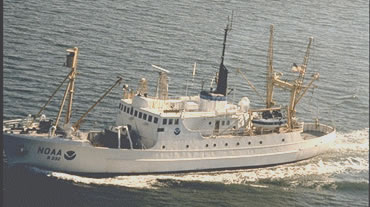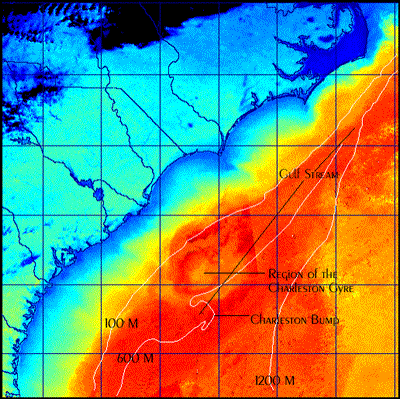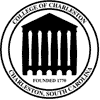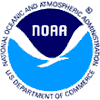The January/February
2003 cruise to the Charleston Gyre is the fourth
leg of a mission titled “Exploration of the Charleston Gyre and
its contribution to the production on the southeast United States continental
 shelf”.
Researchers from the NOAA Center for Coastal Fisheries and Habitat Research
(Beaufort, NC) and Oceanica's Rachel McEvers sailed aboard shelf”.
Researchers from the NOAA Center for Coastal Fisheries and Habitat Research
(Beaufort, NC) and Oceanica's Rachel McEvers sailed aboard
the NOAA Ship OREGON II for 13 days at sea. On this particular cruise
we examined the fate of ichthyoplankton (very small fish larvae) and
zooplankton (very small floating animals) in the region of the meso-scale
eddy formation known as the Charleston Gyre. The vessel pictured above
is the NOAA Ship Oregon II, onboard which the mission was conducted.
Preliminary work indicates
the swirling motion of the eddies that form off the Gulf Stream, brings
nutrient-rich water from deep and off the shelf edge to near surface
and results in enhanced primary production. Therefore, this may be an
ideal place for juvenile fishes to feed as they grow. The reason for
this mission is to assess production of the Charleston Gyre, its contribution
to production of the entire southeastern Atlantic Bight, and its potential
as pelagic spawning and nursery habitat for fishes.

Right now we are making CTD casts every 5 miles. The CTD tells us the
temperature, salinity and depth of the water. By measuring the temperature
and salinity, we are able to determine when we are within the Charleston
Gyre. Once the center of the eddy (gyre) is reached, drifters will be
released. Five are satellite-tracked and one is GPS-tracked from the
ship. The GPS-tracked drifter will be followed. Three MOCNESS (plankton
net) tows will be made in the vicinity of the drifter each night and
one will be made during the day. CTD casts will be made throughout the
cruise to make sure we are still in the eddy. Once the mission is over,
the GPS-tracked drifter will be retrieved. The satellite-tracked drifters
will continue to send information via satellite even after the cruise
is completed.
|





 shelf”.
Researchers from the NOAA Center for Coastal Fisheries and Habitat Research
(Beaufort, NC) and Oceanica's Rachel McEvers sailed aboard
shelf”.
Researchers from the NOAA Center for Coastal Fisheries and Habitat Research
(Beaufort, NC) and Oceanica's Rachel McEvers sailed aboard 